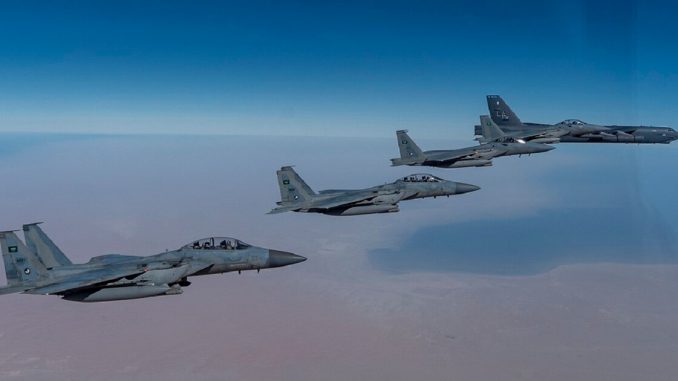
U.S. Air Force B-52H Stratofortress aircrews from the 2nd Bomb Wing completed a long-range, short-duration defensive mission in the Middle East Jan. 27 — marking the third time the bombers have done so in the Middle East this year, according to U.S. Central Command.
The BUFFs departed from Barksdale Air Force base in Louisiana to complete the presence patrol mission, which was designed to deter aggression in the region while integrating with with air operations centers and other AFCENT assets, including F-15E Strike Eagles, F-16 Fighting Falcons, KC-10 Extenders and KC-135 Stratotankers, CENTCOM said in a news release.
The bombers also flew with the aircraft of allies in the region, including Saudi Arabia.
/cloudfront-us-east-1.images.arcpublishing.com/mco/YLRAGD55GZENFC2JJ62SFEZK3U.jpg)
The U.S. has no plans to take a break from such missions in the coming months after conducting a total of six in the Middle East since November, the Wall Street Journal reports, citing U.S. military officials. In fact, more Bomber Task Force missions in the region are scheduled for the spring months.
“Our intent is to maintain that enduring defensive posture, to deter any aggression in the region, promote regional security and assure our allies,” a senior military official said, according to the Wall Street Journal.
Although there have been several explosions in Riyadh recently, Wednesday’s mission had been on the books for weeks and was not completed in response to any specific action, officials said.
The U.S. has been on alert for possible attacks by Iran for several months, beginning around the time of the U.S. presidential election in early November and peaking around Jan. 3, the one-year anniversary of the U.S. airstrike that killed Quds Force Commander Qassem Soleimani. But the cautionary approach continues as the U.S. and Iran forge a new relationship under the Biden administration. The presence of Stratofortresses always carries an element of signal-sending.
/cloudfront-us-east-1.images.arcpublishing.com/mco/CTJ42BXCQREUVKGNWRUGTPYK6E.jpg)
“We do know that U.S. policy is evolving with respect to Iran right now, and the new administration will make some decisions over the next while, and I don’t have any particular insight into what those decisions will be,” the senior official said, according to the Wall Street Journal. “But if we continue to deter Iranian aggression, it will give policy makers more decision space as they set down policy.”
Previous Bomber Task Force missions this year were conducted on Jan. 8 and Jan. 17.
“America doesn’t seek conflict,” U.S. Navy Capt. Bill Urban, U.S. Central Command spokesman, said in a news release Jan. 8. “This mission is a measured approach to demonstrate that we are committed to the defense of our forces in the region and are capable of responding to any aggression on short notice.”



Be the first to comment